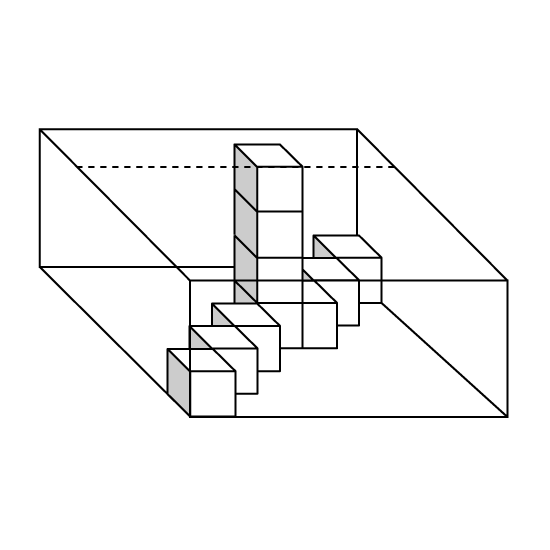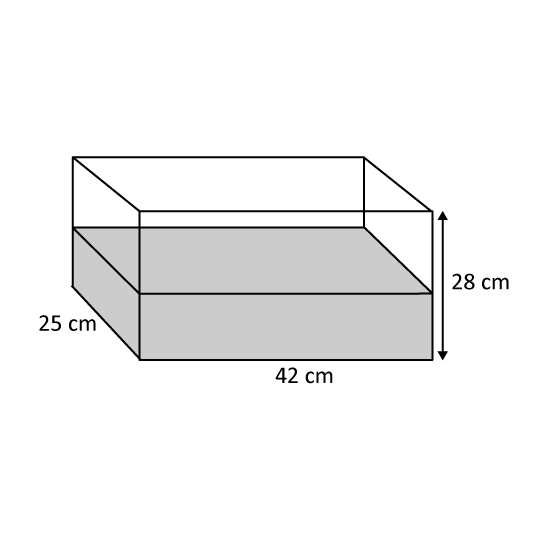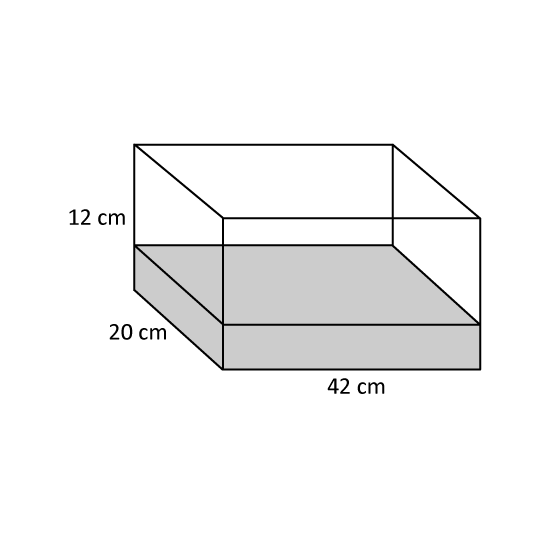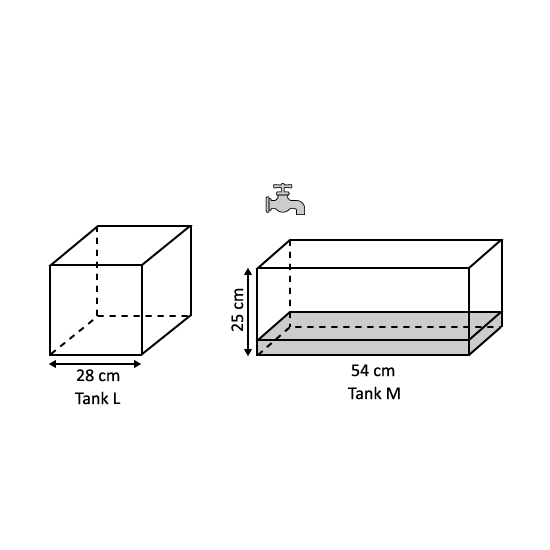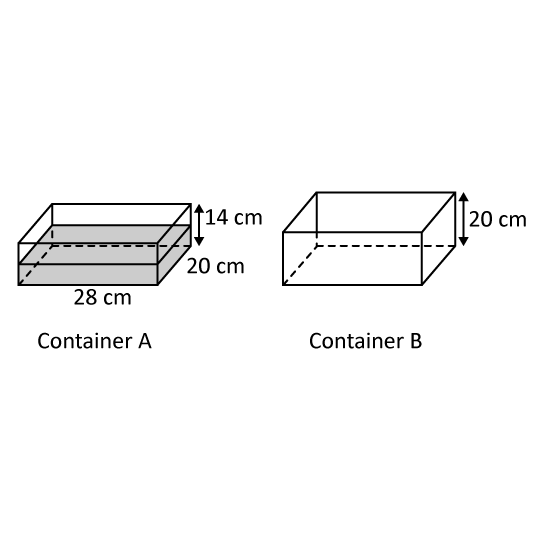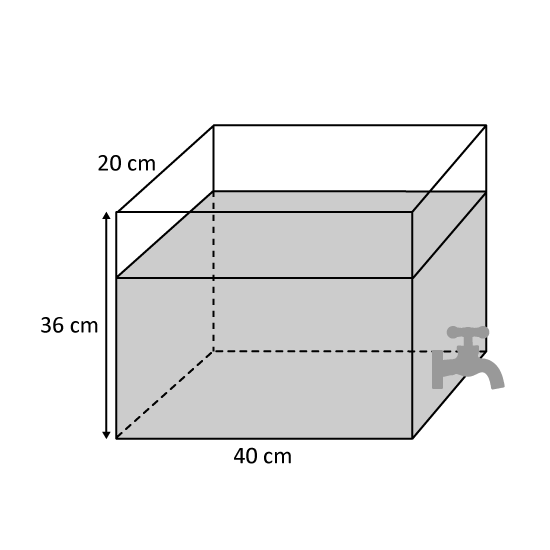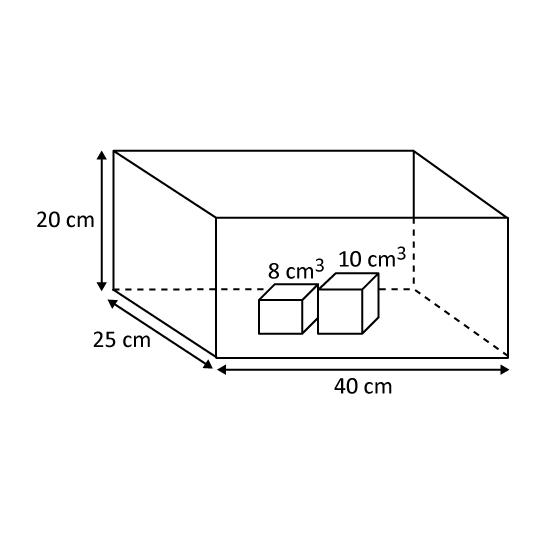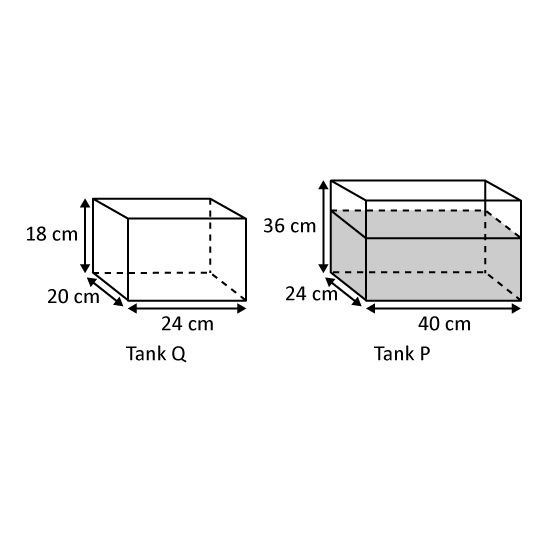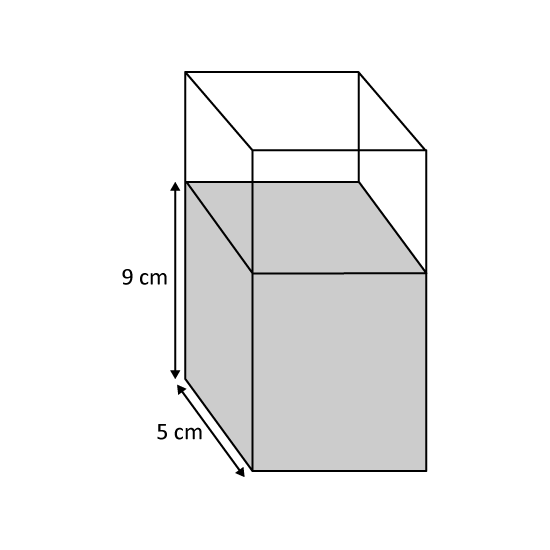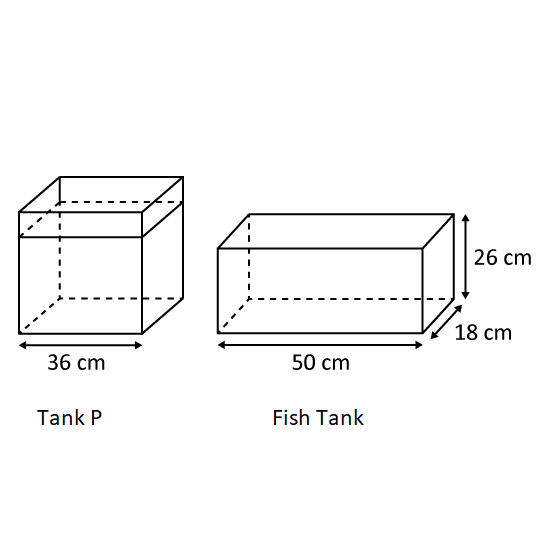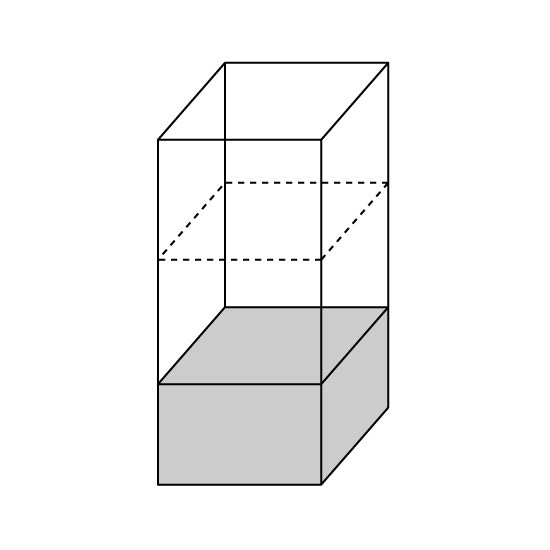Level 2
Silas puts ten 1-cm cubes into a transparent tank.
- What is the volume of the transparent tank?
- How many more 1-cm cubes are needed to fill up the whole tank completely?
Level 2
Silas puts ten 1-cm cubes into a transparent tank.
- What is the volume of the transparent tank?
- How many more 1-cm cubes are needed to fill up the whole tank completely?
Image in this question is not available.
Level 3
Joshua placed a toy in an empty rectangular tank 150 cm long and 50 cm wide. He then filled the tank with water flowing from a tap at a rate of 5 ℓ per minute. It took 3 minutes to fill the tank to a depth of 6.5 cm to cover the toy completely. Find the volume of the toy. Express your answer in cm3.
4 m
Image in this question is not available.
Level 2
In the figure, a fish tank measuring 42 cm by 25 cm by 28 cm was filled with water to its brim. Then, 10.08 ℓ of water was removed from the fish tank. Find the volume of water left in the tank. Express your answer in ℓ.
Level 2
In the figure, a fish tank measuring 42 cm by 25 cm by 28 cm was filled with water to its brim. Then, 10.08 ℓ of water was removed from the fish tank. Find the volume of water left in the tank. Express your answer in ℓ.
Image in this question is not available.
Level 2
A rectangular tank measuring 30 cm by 12 cm by 16 cm was completely filled with water. After some water was poured out from the tank, the height of the water decreased from 16 cm to 11 cm. How much water was poured out from the tank?
3 m
Image in this question is not available.
Level 2
The tank measuring 42 cm by 20 cm by 12 cm was 15 filled with water. After some water was added into the tank, the tank became 34 full. How much water was added to the tank?
Level 2
The tank measuring 42 cm by 20 cm by 12 cm was 15 filled with water. After some water was added into the tank, the tank became 34 full. How much water was added to the tank?
Image in this question is not available.
Level 3
Tank L is a cubical container of edge 28 cm. It is completely filled with water. Tank M is a rectangular tank measuring 54 cm by 24 cm by 25 cm. It is filled with water flowing from a tap at a rate of 1.3 ℓ per minute. 5 minutes later, the tap is turned off.
- Find the volume of water in Tank M after 5 minutes. Give your answer in litres.
- All the water in Tank L is then poured into Tank M without spilling. How much more water is needed to fill Tank M completely? Give your answer in litres.
Level 3
Tank L is a cubical container of edge 28 cm. It is completely filled with water. Tank M is a rectangular tank measuring 54 cm by 24 cm by 25 cm. It is filled with water flowing from a tap at a rate of 1.3 ℓ per minute. 5 minutes later, the tap is turned off.
- Find the volume of water in Tank M after 5 minutes. Give your answer in litres.
- All the water in Tank L is then poured into Tank M without spilling. How much more water is needed to fill Tank M completely? Give your answer in litres.
Image in this question is not available.
Level 3
Container A measures 28 cm by 20 cm by 14 cm was 34 filled with water. When the water was poured into Container B, it was 14 full. Find the base area of Container B if its height was 20 cm.
Level 3
Container A measures 28 cm by 20 cm by 14 cm was 34 filled with water. When the water was poured into Container B, it was 14 full. Find the base area of Container B if its height was 20 cm.
Image in this question is not available.
Level
A rectangular tank 40 cm long, 20 cm wide and 36 cm high was
56 filled with water.
- What was the volume of the water in the tank in litres?
- A tap was used to drain the water from the tank at a rate of 4 ℓ per minute. The tap was turned off when the tank was 13 filled with water. How long did it take to drain the water?
Level
A rectangular tank 40 cm long, 20 cm wide and 36 cm high was
56 filled with water.
- What was the volume of the water in the tank in litres?
- A tap was used to drain the water from the tank at a rate of 4 ℓ per minute. The tap was turned off when the tank was 13 filled with water. How long did it take to drain the water?
Image in this question is not available.
Level 3
The following tank has a square base of side 40 cm. It is filled with water to a height of 8 cm. If 32 ℓ more of water is needed to fill the tank completely, what is the height of the tank?
Level 3
The following tank has a square base of side 40 cm. It is filled with water to a height of 8 cm. If 32 ℓ more of water is needed to fill the tank completely, what is the height of the tank?
Image in this question is not available.
Level 3
Water flows into a tank at the rate of 45 ℓ per minute. After 10 min, the tap is turned off and the tank is 0.6 filled with water.
- How much more water is needed to fill it to the brim?
- The water in the tank is then poured into containers each 1.5 m long, 0.3 m wide and 10 cm high. What is the minimum number of containers needed?
4 m
Image in this question is not available.
Level 2
A rectangular tank measuring in 40 cm by 15 cm by 20 cm is 25 filled with water. How much water is needed to fill the tank to 50% of the capacity? Give your answer in litres.
Level 2
A rectangular tank measuring in 40 cm by 15 cm by 20 cm is 25 filled with water. How much water is needed to fill the tank to 50% of the capacity? Give your answer in litres.
Image in this question is not available.
Level 3
An open tank of depth 20 cm has a horizontal base of length 40 cm and breadth 25 cm. Two wooden cubes, of side 8 cm and 10 cm respectively, rest on the base of the tank.
- Find the capacity of the tank.
- How much water must be poured into the tank so that the tank is half filled?
Level 3
An open tank of depth 20 cm has a horizontal base of length 40 cm and breadth 25 cm. Two wooden cubes, of side 8 cm and 10 cm respectively, rest on the base of the tank.
- Find the capacity of the tank.
- How much water must be poured into the tank so that the tank is half filled?
Image in this question is not available.
Level 3
A rectangular container measuring 55 cm by 50 cm by 23 cm was 110 filled with water. Mary turned on a tap at 9.36 p.m. to fill more water into the container. She turned off the tap at 9.59 p.m. The container was 910 filled with water. Given that the water flowed out of the tap at the same rate, find the volume of water that flowed out of the tap in a minute. Give your answer in litres.
4 m
Image in this question is not available.
Level 3
Tank P measuring 40 cm by 24 cm by 36 cm is 56-filled with water. The water is then poured into another tank, Tank Q measuring 24 cm by 20 cm by 18 cm until it is full. What is the volume of water left in Tank P? Give your answer in cubic centimetres.
Level 3
Tank P measuring 40 cm by 24 cm by 36 cm is 56-filled with water. The water is then poured into another tank, Tank Q measuring 24 cm by 20 cm by 18 cm until it is full. What is the volume of water left in Tank P? Give your answer in cubic centimetres.
Image in this question is not available.
Level 3
At first,
13 of Container B was filled with water and Container C was empty. Then, both taps were turned on at the same time and water from both taps flowed at the same rate of 2.2 litres per minute. Both taps were turned off immediately when Container B was filled to the brim.
- How much water was there in Container B at first?
- How long did it take for the water from the tap to fill Container B to the brim?
- What fraction of Container C was filled with water in the end? Give your answer in the simplest form.
Level 3
At first,
13 of Container B was filled with water and Container C was empty. Then, both taps were turned on at the same time and water from both taps flowed at the same rate of 2.2 litres per minute. Both taps were turned off immediately when Container B was filled to the brim.
- How much water was there in Container B at first?
- How long did it take for the water from the tap to fill Container B to the brim?
- What fraction of Container C was filled with water in the end? Give your answer in the simplest form.
Image in this question is not available.
Level 3
Jean had an empty container of capacity 700 cm3 and a 5-cm square base tank filled with water to a height 9 cm. She filled the container with some water until it is 34 full. She then transferred half of the water from the container into the tank. How much water was there in the tank now?
Level 3
Jean had an empty container of capacity 700 cm3 and a 5-cm square base tank filled with water to a height 9 cm. She filled the container with some water until it is 34 full. She then transferred half of the water from the container into the tank. How much water was there in the tank now?
Image in this question is not available.
Level 3
A rectangular tank measuring 50 cm by 60 cm by 40 cm was completely filled with water. If the water was used to fill some cubical containers of edge 20 cm, how many cubical containers would be fully filled?
3 m
Image in this question is not available.
Level 3 Cubical Tank P has a length of 36 cm and is
79 filled with water. Some of the water is poured into an empty rectangular fish tank measuring 50 cm long, 18 cm wide and 26 cm high until it is completely full.
- What is the volume of water in Tank P at first? Give your answer in cm3
- What is the volume of water left in Tank P? Give your answer in litres.
Level 3 Cubical Tank P has a length of 36 cm and is
79 filled with water. Some of the water is poured into an empty rectangular fish tank measuring 50 cm long, 18 cm wide and 26 cm high until it is completely full.
- What is the volume of water in Tank P at first? Give your answer in cm3
- What is the volume of water left in Tank P? Give your answer in litres.
Image in this question is not available.
Level 3
A rectangular tank measuring 50 cm by 36 cm by 27 cm was 34 filled with water. The water was used to fill up some bottles of capacity 2 ℓ each. How many bottles were filled completely?
3 m
Image in this question is not available.
Level 3
13 of the container is filled by 7 bottles of apple juice.
- What fraction of the container is not filled?
- How many more similar bottles of apple juice are needed to fill the container completely?
Level 3
13 of the container is filled by 7 bottles of apple juice.
- What fraction of the container is not filled?
- How many more similar bottles of apple juice are needed to fill the container completely?
Image in this question is not available.
